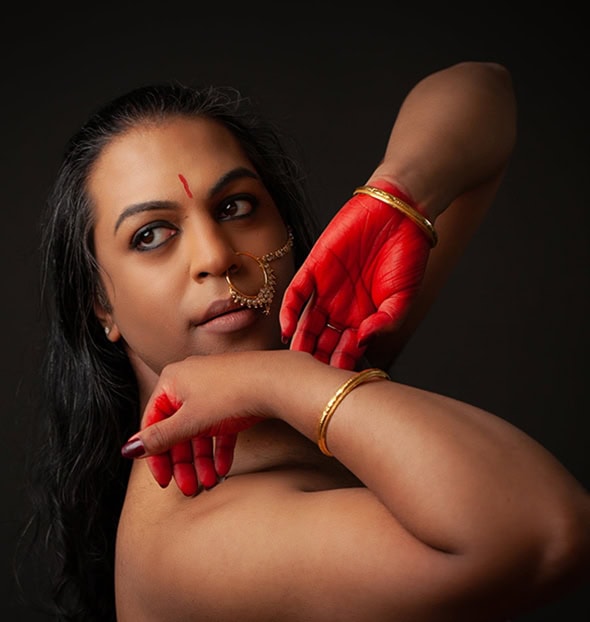Jaivant Patel, YAATRA at Blue Elephant Theatre
Posted: August 20th, 2019 | Author: Nicholas Minns | Filed under: Performance | Tags: Hassan Mohyeddin, Jaivant Patel, Joanne E L Marshall, LGBTQ+, Nahid Siddiqui, Ryan Dawson Laight, YAATRA | Comments Off on Jaivant Patel, YAATRA at Blue Elephant TheatreJaivant Patel, YAATRA, Blue Elephant Theatre, July 16

One of the beauties of watching dance is that the nature of time spent in the theatre expands infinitely when the performance is good (but by the same token, when the performance is not so good, time can simply stretch unsparingly between two points — entry into the theatre and departure from it — with little additional value). Jaivant Patel’s YAATRA, a meditation in two parts that offers ‘a fresh perspective on South Asian LGBTQ+ narratives, faith and spirituality’ is one of those works that expands time as it fluidly crosses national and gender boundaries, and on the tiny stage of Blue Elephant Theatre it defies space as well.
Patel is a striking figure in whom aspects of male and female flow with assured ease and elegance; he also exudes a childlike joy and intensity in all he does that conflicts with the idea of ‘performance’. These qualities make his work unselfconsciously ‘in the moment’ and give his performance, despite the presence of an active creative team behind the work, a sense of inspired improvisation. If the rallying cry of LGBTQ+ is to challenge the notion of binary, Patel is its natural advocate.
There are two works on the program, the first, Awakening, a Kathak piece on which Patel collaborated with choreographer Nahid Siddiqui, and the second, Yaatra, for which Ben Wright, Shane Shambhu and Urja Thakore worked as mentors. The pairing displays two sides of Patel’s art but his ability to blur the distinctions between Kathak and contemporary dance suggests a unity rather than a diversity of form. It’s not that the technical details are lacking; Patel’s gestural and postural Kathak vocabulary is convincing while his musicality, even if he is dancing to recorded music by Hassan Mohyeddin, communicates the vibrant, rhythmic precision of the form. The unity derives rather from Patel’s presence as a traditionalist who questions tradition and a contemporary who invokes it.
In Awakenings Patel subtly subverts Kathak by challenging the traditional notion that gods in Indian mythology can be non-binary, while their human interlocutors cannot. In Yaatra, he explores his contemporary practice in relation to traditional values, both mischievously — “Boys don’t wear scarves”, says a recorded motherly voice as he adjusts one around his shoulders — and sincerely as an LGBTQ+ man of faith living in a culture that has difficulty accepting the combination. Awakenings and Yaatra thus form a seamless narrative line that shuttles between past and present in which Patel is the constant — and consistent — narrator of his search for validation.
The theatre is evidently where Patel feels at home and can let go; in the relationship between himself and his audience he can — and does — hold court with evident delight and without fear of censure, even if he suggests — especially in Yaatra — that thespian freedom is no match for society’s prejudices. The stage is conceived as a spiritual locus, subtly lit by Joanne E L Marshall, with its overhead grid of small hanging bells that Patel can strike at arm’s length or set in motion, and Ryan Laight’s rich red tunic and complementary scarves establish Patel within a dual framework of traditional costume — replete with ankle bells — and gender fluidity. Patel is in his element, and it shows. At the end of Awakenings he lets down his long, black hair as if signalling the relaxation of one identity and preparing us for the next; it is still Patel, of course, but in Yaatra he takes on a more secular idiom while maintaining the signification of his cultural heritage.
He returns in his red tunic and ankle bells but with a bag over his shoulder that he sets down as if for a picnic. Out comes a banana that he will later eat with relish. Immersing us in his personal iconography, Patel luxuriates in the sense of time and space it provides, but throughout there is a sense of internal dialogue marked by Ali Harwood’s concise fragments of spoken word that act like signposts. Patel’s choreographic journey is one of coming to terms with himself and with choices he has made; one of Harwood’s ‘signs’ states, ‘So how we act becomes our skin.’ If Awakenings sees Patel supported by his cultural heritage, Yaatra sees him setting out on his own symbolic journey. The final upbeat rhythms and swinging bells read like an anthem of hope and Patel’s final gesture of emptying a scarf full of ankle bells on the floor one of relinquishing the confines of tradition.